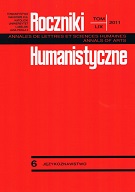Sposoby wykorzystywania potencji semantycznej derywatów słowotwórczych w tekstach literackich Karola Wojtyły
Ways of Using the Semantic Potential of Comlpex Lexical Items in the Literary Works by Karol Wojtyła
Author(s): Anna KozłowskaSubject(s): Language and Literature Studies
Published by: Towarzystwo Naukowe KUL & Katolicki Uniwersytet Lubelski Jana Pawła II
Keywords: Karol Wojtyła; word formation; artistic language; poetic text; complex (derived) words; semantics; dashes; syntactic requirements; context
Summary/Abstract: This paper discusses how the semantic potential of derived lexical items is employed by Karol Wojtyla in his artistic writings. In most cases, the poet experimented with word formation patterns in order to emphasize the formal and semantic dichotomies in the derivates he introduced. However, his works also contain a considerable number of modifications in the semantics of the existing, motivated lexemes. To signal semantic operations on complex words, WojtyPa uses dashes as well as changes in the semantic requirements of the derived lexical items and their lexical context. Used in WojtyPa’s works, these methods result in: 1. bringing up-to-date the lexical (and etymological) meaning of lexicalized items; 2. modification of the whole complex word through semantic alterations concerning its constituent parts; 3. introducing a paradigmatic semantic relationship between complex words that display formal resemblance; 4. textual ambiguity caused by introducing derived homonyms.
Journal: Roczniki Humanistyczne
- Issue Year: 59/2011
- Issue No: 06
- Page Range: 153-167
- Page Count: 15
- Language: Polish

